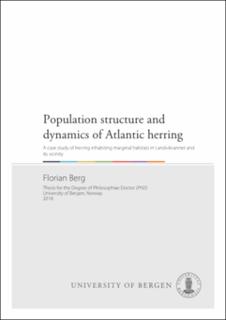| dc.contributor.author | Berg, Florian | |
| dc.date.accessioned | 2018-05-03T08:51:46Z | |
| dc.date.available | 2018-05-03T08:51:46Z | |
| dc.date.issued | 2018-05-04 | |
| dc.identifier.uri | https://hdl.handle.net/1956/17678 | |
| dc.description.abstract | Knowledge about the structure and dynamics of marine fish populations is essential for their conservation and management to maintain biodiversity and population complexity. Atlantic herring (Clupea harengus) is one of the ecologically and commercially most important fish species in the northeastern Atlantic and well-known for its complex population structure. However, the actual population structure and dynamics are still debated and partly resolved. To expand the knowledge, the purposes of this thesis were (1) to identify herring populations and their population structure in a case study area based on phenotypic and biological characteristics, and (2) to examine whether these distinct characteristics can be used for population discrimination on a broader scale. Within the case study area, three distinct herring populations could be identified based on behavioral and phenotypic differences such as vertebral counts, length-at-age, otolith shape, and otolith microstructure. The spatial and temporal overlap and potential interbreeding between these three populations suggest that they form a metapopulation. The existence of a metapopulation would have a significant influence on the current management approach. Further, mixing of several populations could have been demonstrated on a broader scale, but an individual assignment being essential for a sustainable management was not feasible. Finally, hybrids of two herring populations have been reared until maturity in a common garden experiment showing that phenotypic characteristics were controlled by genetic factors to a larger extent than by salinity. The results of this thesis provide novel insight into the population structure and dynamics of herring, the factors influencing phenotypic traits, and potential implications for management purposes. Furthermore, the findings contribute new knowledge about several population identification methods strengthening their application to resolve the complex population structure of Atlantic herring. This thesis highlights the importance of recognizing herring dynamics and understanding the mixing of populations as a challenge for management of herring. | en_US |
| dc.language.iso | eng | eng |
| dc.publisher | The University of Bergen | en_US |
| dc.relation.haspart | Paper I: Eggers, F., Slotte, A., Libungan, L. A., Johannessen, A., Kvamme, C., Moland, E., Olsen, E. M., and Nash, R. D. M. 2014. Seasonal dynamics of Atlantic herring (Clupea harengus L.) populations spawning in the vicinity of marginal habitats. PLoS ONE 9(11): e111985. The article is available at: <a href="http://hdl.handle.net/1956/9434" target="blank"> http://hdl.handle.net/1956/9434</a> | en_US |
| dc.relation.haspart | Paper II: Eggers, F., Olsen, E. M., Moland, E., and Slotte, A. 2015. Individual habitat transitions of Atlantic herring Clupea harengus in a human-modified coastal system. Mar. Ecol. Prog. Ser. 520: 245-256. The article is available at: <a href="http://hdl.handle.net/1956/9417" target="blank"> http://hdl.handle.net/1956/9417</a> | en_US |
| dc.relation.haspart | Paper III: Berg, F., Husebø, Å., Godiksen, J. A., Slotte, A., and Folkvord, A. 2017. Spawning time of Atlantic herring (Clupea harengus) populations within a restricted area reflects their otolith growth at the larval stage. Fish. Res. 194: 68-75. The article is available in the main thesis. The article is also available at: <a href="https://doi.org/10.1016/j.fishres.2017.05.009" target="blank">https://doi.org/10.1016/j.fishres.2017.05.009</a> | en_US |
| dc.relation.haspart | Paper IV: Berg, F., Slotte, A., Johannessen, A., Kvamme, C., Clausen, L. A. W., and Nash, R. D. M. 2017. Comparative biology and population mixing among local, coastal and offshore Atlantic herring (Clupea harengus) in the North Sea, Skagerrak, Kattegat and western Baltic. PLoS ONE 12(10): e187374. The article is available at: <a href="http://hdl.handle.net/1956/17171" target="blank"> http://hdl.handle.net/1956/17171</a> | en_US |
| dc.relation.haspart | Paper V: Berg, F., Almeland, O. W., Skadal, J., Slotte, A., Andersson, L., and Folkvord, A. 2017. Genetic factors have a major effect on growth, number of vertebrae and otolith shape in Atlantic herring (Clupea harengus). PLoS ONE 13(1): e0190995. The article is available at: <a href="http://hdl.handle.net/1956/17538" target="blank"> http://hdl.handle.net/1956/17538</a> | en_US |
| dc.title | Population structure and dynamics of Atlantic herring. A case study of herring inhabiting marginal habitats in Landvikvannet and its vicinity | en_US |
| dc.type | Doctoral thesis | |
| dc.rights.holder | Copyright the author. All rights reserved | en_US |
| dc.identifier.cristin | 1580499 | |
